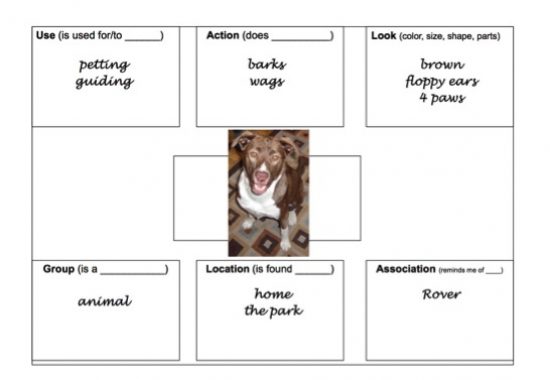Semantic feature analysis (SFA) is a procedure used to train people to produce semantic information when they have difficulty accessing the specific word or label they want to say. Training typically involves auditory and visual cueing to facilitate provision of particular pieces of information. A typical visual cue might look something like this.

The clinician will guide a client to produce a response to each question, typically using the same sequence of cues for each word practiced. The information produced by the client can be written on a copy of the SFA chart (as seen above) to provide additional cueing and also to measure change over time in clients’ production of feature information. Each turn ends after review of all features either with the client producing the name of the item or repeating the name as produced by the clinician. As treatment progresses, clients often improve in naming practiced items, both for object names (i.e., nouns) and action names (i.e., verbs). In addition, clients may habituate use of the procedure and begin to use it spontaneously as a strategy for semantic self-cueing and semantic circumlocution.
Use of SFA to improve naming of specific treatment items is most commonly done in the context of individual treatment, with repeated practice of a set of specific items. However, there is evidence that repeated practice of the strategy in group aphasia treatment, wherein members receive less practice overall and often do not repeat practice for the same item more than once, can also result in improvement in clients’ ability to retrieve content words. The strategy can be practiced in the context of barrier activities, with clients taking turns describing pictures, picture sequences or real objects. It can also be practiced without the use of additional visual supports, such as when clients are retelling personal stories, recounting their weekend’s activities, or describing the most recent movie they’ve seen. Not only can the client describing the picture or telling the story use the strategy, but listeners can also use it to request additional information or clarification. An SFA chart may be enlarged and laminated for use by all group members during treatment, and also reduced to business card size for clients to use during home practice. Evidence suggests that clients with aphasia most likely to derive benefit from using this strategy are those with relatively preserved 1) auditory comprehension for functional communication and 2) nonlinguistic cognitive function (e.g., attention, working memory, metacognition).
References/Resources:
Antonucci, S.M. (2009). Use of semantic feature analysis in group aphasia treatment. Aphasiology, 23(7/8), 854-866.
Boyle, M. (2004). Semantic Feature Analysis Treatment for Anomia in Two Fluent Aphasia Syndromes. American Journal of Speech-Language Pathology, 13, 236-249.
Falconer, C. & Antonucci, S.M. (2012). Use of semantic feature analysis in group aphasia treatment: Extension and Expansion. Aphasiology, 26(1), 64-82
Maddy, K.M., Capiluto, G.J., & McComas, K.L. (2014). The effectiveness of semantic feature analysis: An evidence-based systematic review. Annals of Physical and Rehabilitation Medicine, 57, 254-267
Muñoz, M.L. (2014). Recipe SLP: The clinician’s guide to semantic feature analysis for aphasia.
Wambaugh, J.L. & Ferguson, M.F. (2007). Application of semantic feature analysis to retrieval of action names in aphasia. Journal of Rehabilitation Research and Development, 44(3), 381-394.
For more information, see our website or contact Sharon Antonucci at antonucs@einstein.edu.


4 comment on “Activities for aphasia groups (vol. 1): Semantic Feature Analysis”